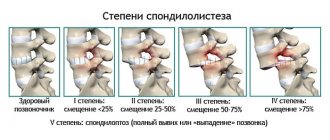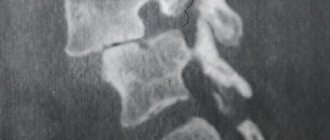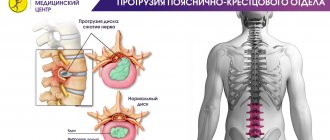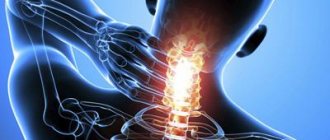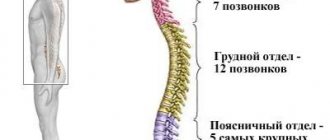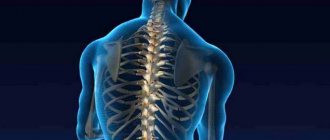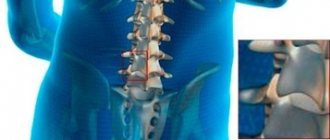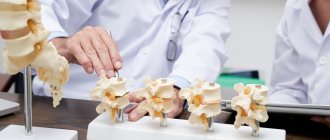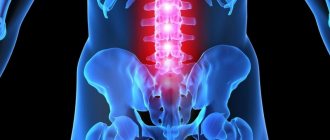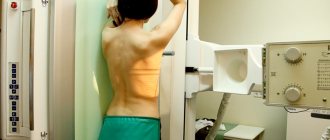September 24, 2019
18292
0
4 out of 5
The term spondylolisthesis means slippage of a vertebra. As a result, one of the vertebrae is displaced relative to the underlying one, which can lead to neurological disorders and a number of other complications. In most cases, the cervical and lumbar spine is affected, spondylolisthesis of L5–S1, L4–L5, C3–C4 is especially common.
The pathology occurs in people of all ages, including children. In the latter case, it carries a particular danger, since changes in the anatomy of the spine of a rapidly growing organism very quickly leads to serious disruptions in the functioning of all organs and systems. Therefore, it is important to diagnose spondylolisthesis of the cervical or lumbar spine as early as possible and carry out proper treatment of the joints.
You can undergo a full diagnostics using the latest equipment and accurately determine the causes of back and neck pain at SL Clinic. With our help, you can find out in a timely manner what is causing discomfort and get advice from specialists in the field of vertebrology and spinal surgery. Our doctors are able to notice the slightest deviations from the norm in the spine and select the optimal treatment tactics, which will eliminate any unwanted symptoms in the shortest possible time and avoid the development of dangerous complications.
Types of spondylolisthesis
The main reason that spondylolisthesis occurs in the lumbosacral spine or other area is the destruction or initially insufficient fusion of the vertebral arch connecting the joints. Injuries, arthrosis, osteochondrosis and other similar diseases provoke an increase in the defect, as a result the vertebra becomes mobile and slides off the surface of the intervertebral disc.
When the vertebra moves backward, posterior spondylolisthesis is diagnosed, and when it moves forward, anterior spondylolisthesis is diagnosed. Sometimes combined deformities occur, in which the vertebrae are displaced in different directions. In some cases, especially against the background of arthrosis or osteochondrosis, staircase spondylolisthesis of the cervical spine is observed, for which simultaneous displacement of several vertebrae in one direction is typical.
To select the correct treatment tactics, it is important to differentiate false spondylolisthesis of L4–L5 and other segments, since this type of disorder is not characterized by pathological changes in the interarticular arch. With pseudospondylolisthesis, segments are displaced due to the presence of anatomical features of the spine during sudden movements. But diagnosing this form of the disease does not mean that it cannot lead to pinched nerves and other disorders. Like true L3–L4 spondylolisthesis, it requires treatment, but it will be of a slightly different nature.
Possible consequences
If a vertebra is displaced, serious complications can develop. This is explained by the fact that compression of the bone elements of nearby anatomical formations occurs.
Spondylolisthesis leads to the following disorders:
- Thyroid disease.
- Malfunction of the nervous system.
- Hypertension.
- Hearing and vision decrease.
- There are difficulties with breathing.
- Incontinence of natural secretions.
- The spine is bent.
- Sometimes impotence develops.
Complications often require surgery. Unfortunately, some consequences are not eliminated at all. Therefore, timely diagnosis followed by adequate treatment is necessary.
Symptoms of the disease
Initially, the pathology is asymptomatic, but as it progresses, patients begin to suffer from pain of varying intensity in the neck, lower back, coccyx or sacrum. Also typical are impaired mobility and neurological disorders, manifested by decreased sensitivity of the limbs, headaches, deterioration of hearing, vision, and functioning of the pelvic organs. Sometimes a violation of posture is noticeable due to a decrease in the length of the affected segment.
At the initial stages of development, treatment of spinal spondylolisthesis is carried out using conservative therapy, but since it practically does not manifest itself in any way, it is difficult to diagnose the disease during this period. In severe cases, it can only be dealt with surgically.
Vertebrologists at SL Clinic will help you get rid of the discomfort that accompanies degenerative spondylolisthesis. Our specialists are capable of performing operations of any degree of complexity, and the availability of the best modern equipment, combined with the high level of skill of doctors, reduces the risks of surgical intervention to a minimum. The spinal surgeon will thoroughly explain what vertebral spondylolisthesis is, give an objective assessment of the situation, select the most effective treatment method, and further guide the patient until complete recovery.
Thoracic region
I vertebra: Asthma, shortness of breath, cough.
II vertebra: All kinds of cardiac disorders.
III vertebra: Bronchitis, pleurisy, pneumonia.
IV vertebra: Cholecystitis, herpes zoster.
V vertebra: Circulatory disorders, hypotension and anemia, liver disease, arthritis.
VI vertebra: Various stomach diseases: gastritis, heartburn, ulcers, etc.
VII vertebra: Duodenitis, pancreatitis.
VIII vertebra: Disturbances in the functioning of the spleen.
IX vertebra: Impaired functioning of the adrenal glands.
X vertebra: Various kidney diseases
XI vertebra: Skin diseases: eczema, acne, furunculosis.
XII vertebra: Pain in the intestines, rheumatism, infertility.
Degrees of spondylolisthesis and indications for surgery
There are 5 degrees of vertebral displacement:
- 1st degree – the displacement does not exceed ¼ of the vertebral area, discomfort occurs only during physical exertion or sudden movements;
- 2nd degree - the vertebra is displaced by half, which is associated with the constant presence of pain and some decrease in mobility in the affected area;
- 3rd degree – the displacement is within 75%, which is manifested by increased pain and often the addition of neurological disorders;
- 4th degree – the displacement exceeds ¾ of the surface area of the vertebra, this forces the patient to significantly limit his movements and experience severe pain even in a calm state;
- Grade 5 – the vertebra falls out completely.
Surgical treatment of spondylolisthesis is necessarily prescribed for grades 2,3,4 and 5, if the vertebrae remain in an incorrect position, regardless of the patient’s posture. For unstable spondylolisthesis, in which displacement occurs as a result of changes in body position, surgical intervention is recommended already at grade 1.
It is also always indicated for children under 14 years of age, even if grade 1 spondylolisthesis of the lumbosacral spine is diagnosed. This is due to the fact that the disease tends to progress quickly and cause serious damage to the child’s health.
In other cases, surgery can also be performed if conservative therapy carried out for six months does not bring results and a deterioration in the patient’s condition is observed:
- increase in pain;
- increased neurological symptoms, in particular the occurrence of radicular syndrome, the development of stenosis;
- increasing the degree of vertebral displacement.
Diagnostics
In most cases, it is not possible to visually determine the presence of spondylolisthesis based on physical examination. In addition, complaints with spondylolisthesis are not specific and are similar to those with other spinal diseases.
Therefore, spondylolisthesis can only be diagnosed using instrumental research methods. Spondylolisthesis is easily diagnosed using plain radiographs. Lateral x-rays clearly show how much displacement of a vertebra has occurred in relation to another. The degree of spondylolisthesis is determined depending on the percentage of displacement in relation to the underlying vertebra.
- I degree of slip up to 25%,
- II degree from 26% -50%
- III degree from 51% -75%
- IV degree from 76% and 100%
- Grade V, or spondyloptosis, occurs when a vertebra extends completely beyond the boundaries of another vertebra.
If the patient complains of pain, numbness, tingling or weakness in the legs, additional tests may be prescribed. These symptoms may be caused by stenosis of the spinal canal or foramina.
In such cases, CT or MRI is prescribed, which make it possible to visualize not only the presence of listhesis, but also other morphological changes in the spine.
In addition, if a tumor is suspected or the cause of a defect in the bone needs to be determined, a PET scan may be prescribed, which is based on the difference in the absorption of a radioactive substance depending on the rate of metabolic processes in areas of bone tissue.
Types of operations for spondylolisthesis
The main tasks of the surgeon are to restore the normal position of the vertebrae along with the nerve endings and their reliable fixation. This can only be achieved surgically. The choice of a specific technique is carried out mainly on the basis of the results of MRI diagnostics.
Orthopedic surgery
Surgical treatment of spondylolisthesis with this method involves fastening the vertebrae restored to their normal position with a special plate and fixing them with special screws. This ensures high-quality fusion of the vertebral bodies affected by spondylolisthesis and prevents recurrence of the disease in this segment.
The orthopedic technique provides a high percentage of complete recovery if all recommendations received from the doctor are followed during the rehabilitation period. But it can only be carried out if there are no neuralgic disorders.
Neurosurgical operation
Spondylolisthesis of the vertebra is often combined with pinched nerves of the spine, which provokes severe pain. In such situations, patients need the help of a qualified spinal surgeon who can carefully remove the pressure of anatomical structures on the nerve endings and the correct position of the vertebrae.
Spinal surgeons at SL Clinic will be able to accurately determine the cause of the pain syndrome and, with pinpoint precision, eliminate it in the most effective way. With our help, you will quickly get rid of all the symptoms accompanying spondylosis and spondylolisthesis and be able to return to a full life without pain.
The main causes of nerve compression are herniated discs, narrowing of the root canal and central spinal stenosis. After an accurate diagnosis, patients are recommended to undergo one or another operation:
- Discectomy and spinal stabilization. Open surgery is traditionally used to repair herniated discs. It involves resection of the part of the disc that compresses the nerve roots. This leads to disruption of the stability of the spinal column, which requires the installation of a graft taken from the ilium or an implant made of synthetic materials. The vertebrae adjacent to the resected disc are connected with special rods or screws.
- Foraminotomy. The procedure can be performed on all parts of the spine and is characterized by low invasiveness and a high level of safety. It is indicated for reducing the area of the natural openings of the spine through which nerve endings pass, which often accompanies lumbar and cervical spondylolisthesis. During the operation, the surgeon artificially expands the root canals, due to which the effect of decompression of the nerves is observed and pain is eliminated.
- Laminectomy followed by stabilization of damaged segments. This type of surgical intervention is necessary for stenosis, accompanied by a narrowing of the spinal canal in which the spinal cord passes. When it is pinched, sharp, severe pain occurs. They can only be eliminated by resection of the vertebral arches in the affected area and removal of some of the excess scar tissue that puts pressure on the nerves. After laminectomy, it is necessary to stabilize the spinal segments, for which one or another system is selected.
If there is a choice, most often, preference is given to a stabilizing technique using interbody corporedesis with implants.
Spine surgeons at SL Clinic are fluent in the most modern methods of surgical treatment of spinal diseases. The exact type of intervention is always determined individually and depends on the degree of spondylolisthesis of the lumbosacral spine.
Cervical region
I vertebra: Neuroses, insomnia, dizziness, memory impairment, hypertension, runny nose.
II vertebra: Ear pain, hearing impairment, squint, dizziness and fainting, allergies.
III vertebra: Neuralgia, neuritis, acne.
IV vertebra: Qatar of the respiratory tract, adenoiditis.
V vertebra: All kinds of ENT diseases, tonsillitis, laryngitis.
VI vertebra: Tonsillitis, whooping cough, stiff neck.
VII vertebra: Diseases of the thyroid gland, inflammation of the elbow joint (bursitis).
Features of preparation
Initially, an MRI is performed, the results of which determine the degree of displacement, the percentage of deformation and narrowing of the intervertebral discs. It is also necessary to perform an X-ray of the cervical or lumbar region in two standard projections with functional tests in the lateral projection. Based on this, it is chosen which spine surgery will be performed for spondylolisthesis.
As part of the preoperative examination, the following is prescribed:
- UAC and OAM;
- Doppler ultrasound of the vessels of the lower extremities;
- CT;
- electromyography.
Surgical complications.
- Bleeding from the veins of the epidural tissue during microsurgical discectomy and vertebral reduction is possible quite often. With the surgeon's leisurely actions using a coagulator with a low current intensity, eliminating the “burning” of the vessel walls, the likelihood of heavy bleeding decreases. Bleeding from the veins of the epidural tissue during vertebral reduction is treated with tamponade with hydrogen peroxide wipes.
- Damage to the roots is possible when the root is retracted during microdiscectomy and when pedicle screws are inserted incorrectly.
- Neurological disorders after reduction. The system of vertebral reduction carried out by various transpedicular screws is very powerful and the reduction should be carried out very carefully under visual control of the tension of the roots.
Rehabilitation
The severity of the result of the surgical intervention largely depends on the correctness of the recovery period. The entire set of measures prescribed by specialists is aimed at eliminating the likelihood of relapse and the development of complications of the disease.
Surgical treatment of spondylolisthesis of the lumbosacral spine does not require prolonged bed rest in the postoperative period. You can get up for the first time only with the permission of the surgeon the next day. Any sudden movements or bends are unacceptable. You should refrain from lifting heavy objects and strenuous physical activity for at least 6 months.
Throughout the recovery period, pain of varying degrees of intensity may occur, as the installed screws and rods put pressure on the vertebrae. To eliminate them, painkillers from the NSAID group are prescribed.
In order to speed up recovery, patients are prescribed a course of physiotherapeutic procedures:
- laser therapy;
- electrophoresis;
- sinusoidal modulated currents;
- diadynamic therapy.
For each patient, the nature and duration of procedures is selected individually. Physical therapy is also mandatory. You should start regular exercise 2–4 months after surgery. Classes are recommended to be carried out under the supervision of experienced rehabilitation therapists who will be able to select the optimal load and list of exercises. Initially, they are performed from a lying position on the stomach or back. Gradually increase the duration of classes and the number of repetitions, complicate the exercises and add new ones.
Patients are recommended to wear a semi-rigid corset for 1 month. It will reduce the load on your back muscles and make movement easier. However, you should not use the corset for more than the recommended time, as this may weaken muscle tone too much and lead to re-occurrence of spinal problems. Regular swimming exercises have a beneficial effect on the condition of patients. Therefore, after completing the main stage of rehabilitation, with the permission of the attending physician, it is recommended to visit the pool at least twice a week.
Lumbosacral region
I vertebra: Problems with the colon, stool disorders.
II vertebra: Acidosis, appendicitis, cramps in the thigh muscles.
III vertebra: Menstrual irregularities, miscarriage, bladder disease, impotence.
IV vertebra: Painful urination, pinched sciatic nerve, lower back pain.
V vertebra: Cramps in the lower leg, swelling of the ankles, paresthesia in the legs.
Listhesis of the sacrum leads to curvature of the entire spine, and of the coccyx - to hemorrhoids and pain in the coccyx.
Treatment of spondylolisthesis at SL Clinic
Modern medicine can offer many treatment options for various spinal diseases. Unfortunately, they are often diagnosed in late stages, when the only option to help the patient is surgery. But if previously, for its high-quality implementation, Russians were forced to go to Israel, Germany and other countries and significantly overpay for medical services, today the latest achievements in the field of spinal surgery are successfully implemented in practice in Moscow at the SL Clinic.
Physical therapy
Physical therapy can play a vital role in conservative treatment. Once the patient's acute pain subsides, the doctor develops a rehabilitation program to prevent further displacement of the vertebra.
These programs often include heat, cold, and physical therapy techniques to relieve pain, reduce swelling, increase strength, and promote recovery. Rehabilitation methods include exercise therapy, manual therapy, functional training, and the use of assistive devices and adaptive equipment to increase strength, range of motion, endurance, tissue healing, and functional independence.
